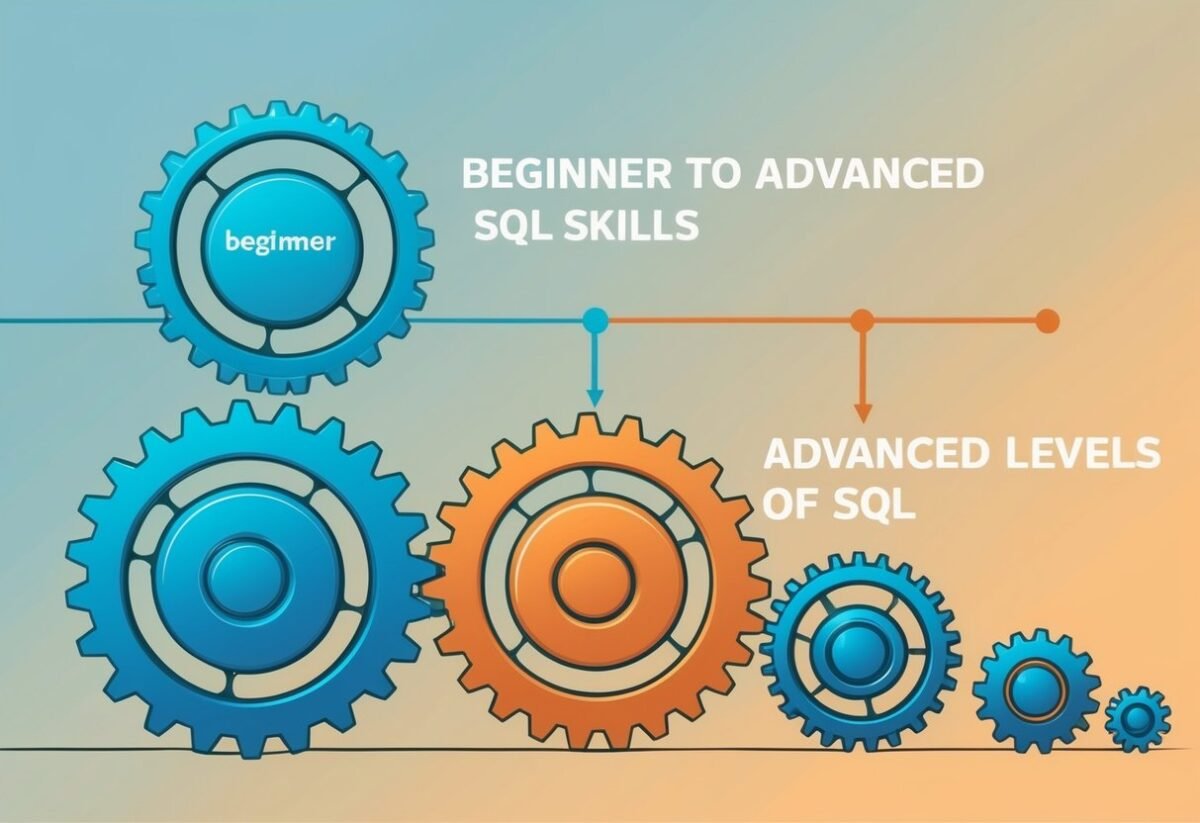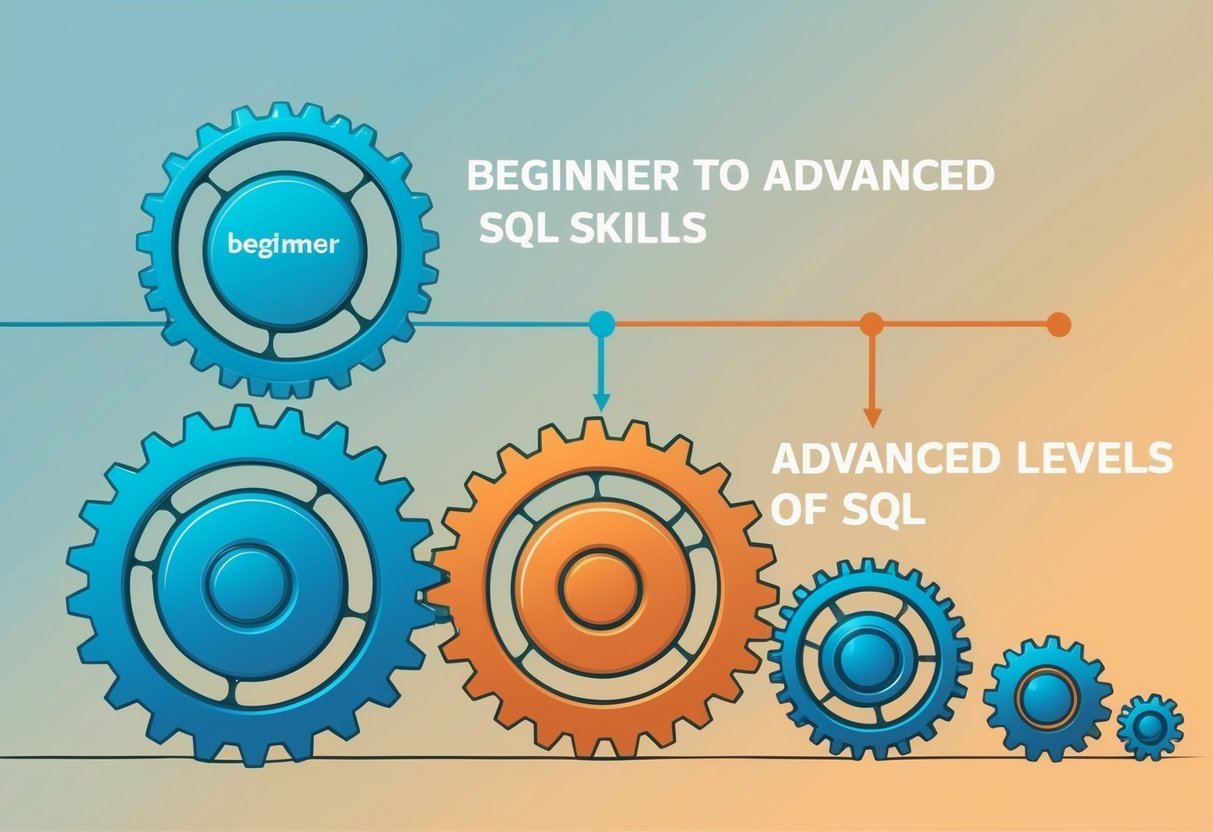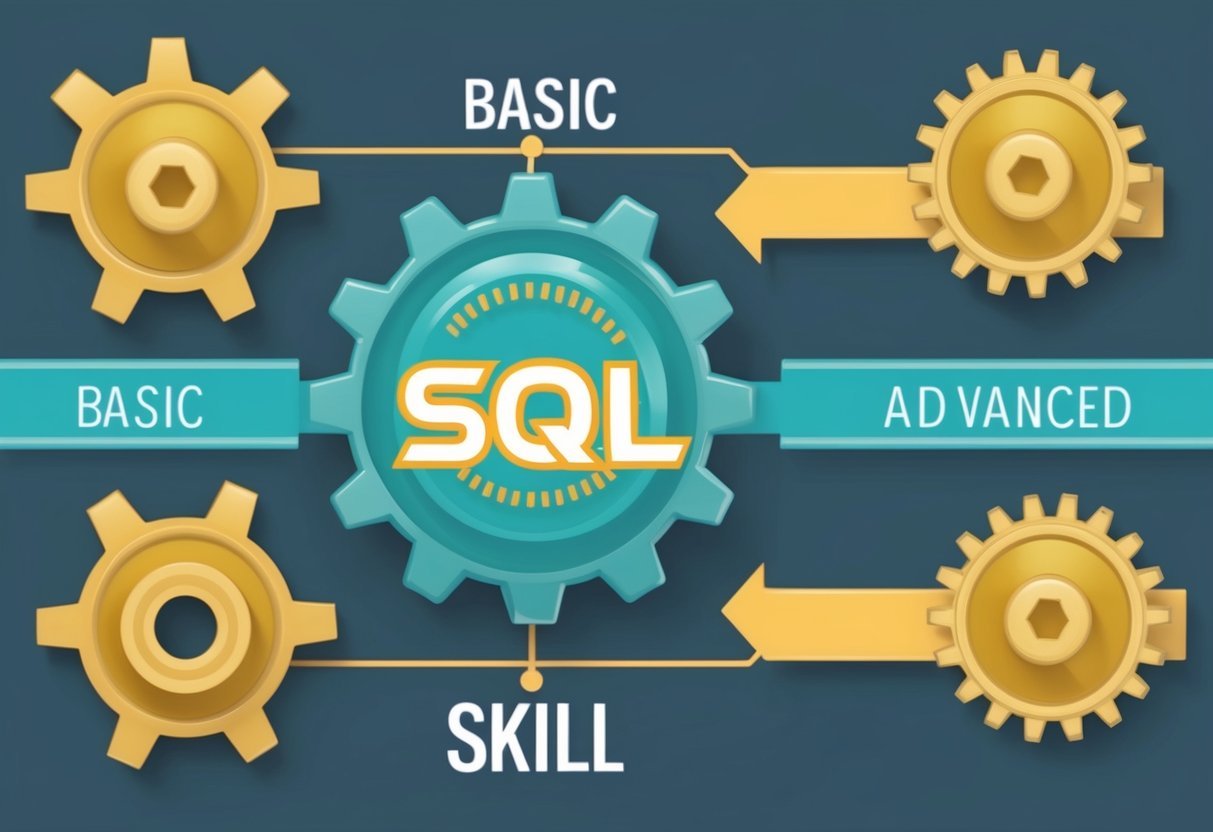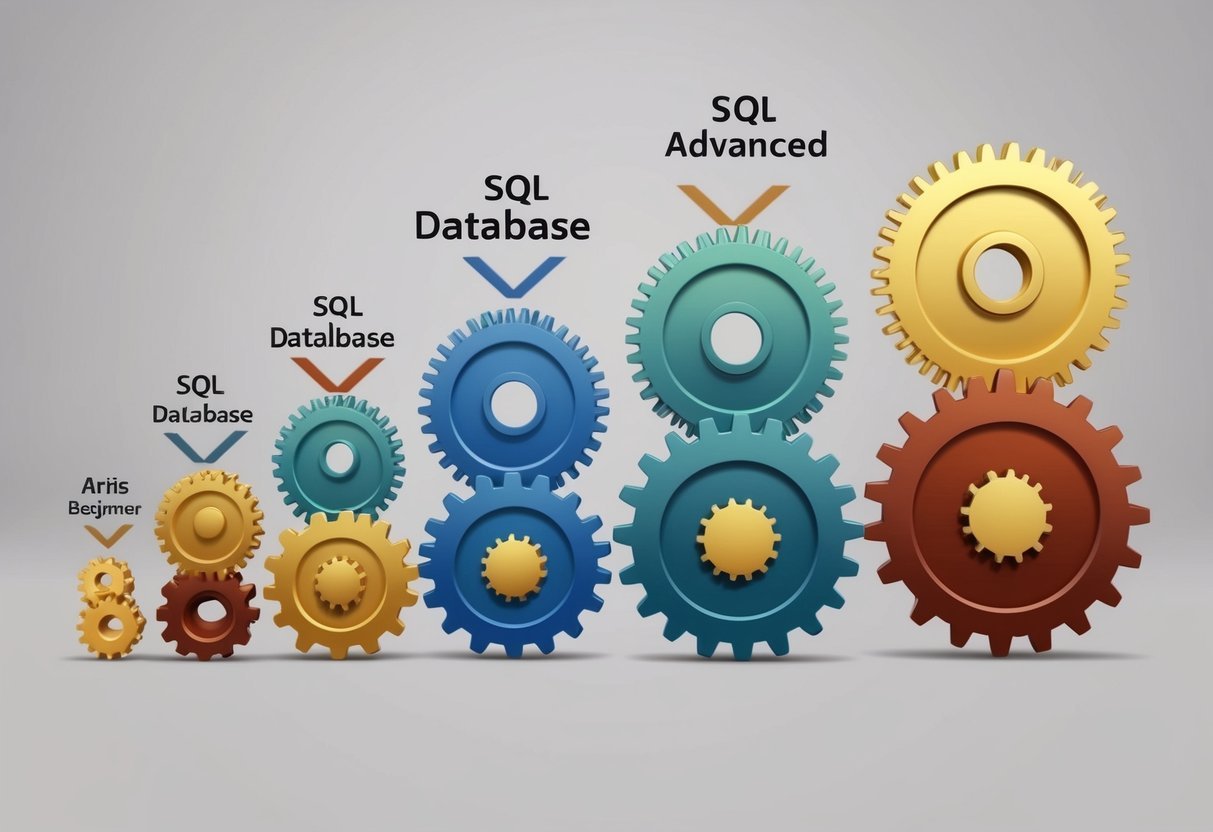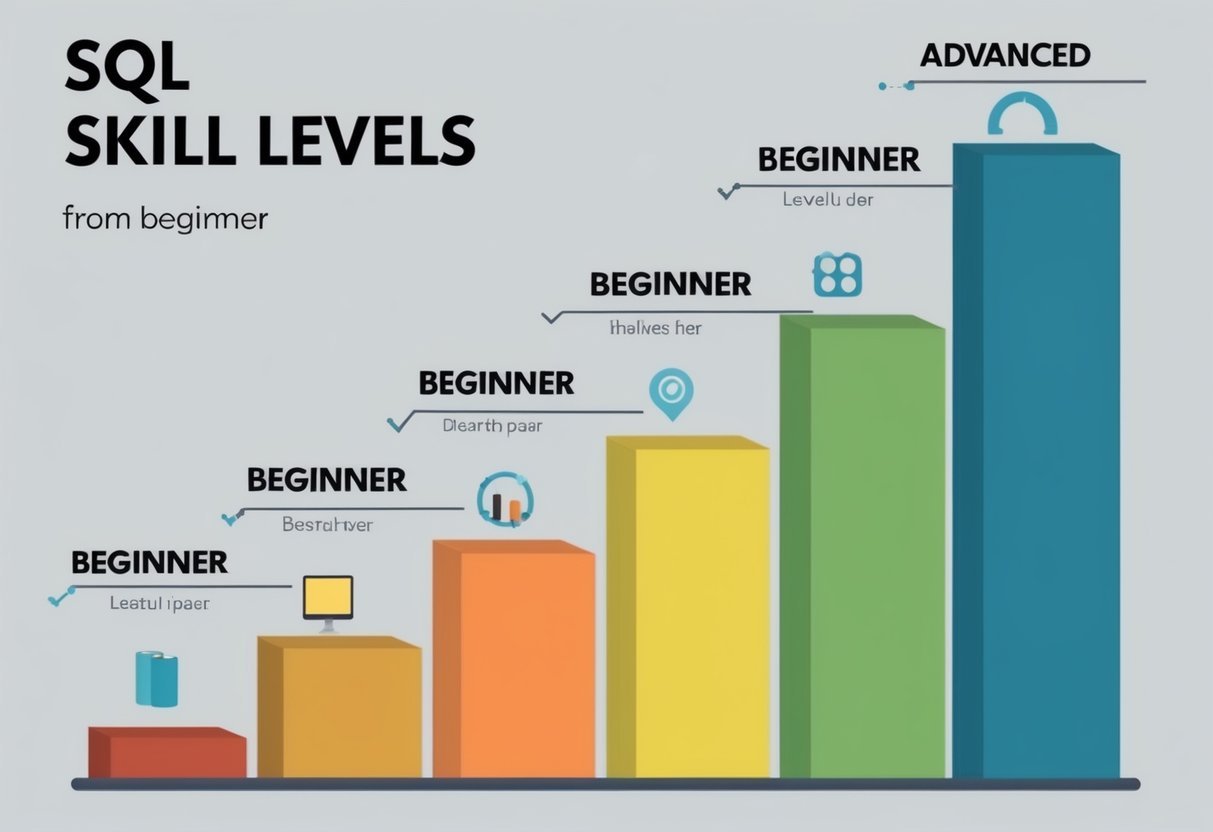Understanding SQL and Its Functions
Structured Query Language (SQL) is an essential tool for database management. It allows users to interact with databases by performing tasks such as querying, updating, and managing data.
SQL is widely used by developers and data analysts to handle various database operations efficiently.
SQL functions are built-in routines that help perform complex operations. They can be categorized into several types including aggregate functions like AVG() and SUM(), string functions, and date functions.
These functions simplify complex data manipulations and improve query performance.
Aggregate functions are used to perform calculations on a set of values. For example, COUNT() helps count rows while MIN() and MAX() are useful for finding minimum and maximum values in a dataset.
These are especially handy for data analysts who need to summarize data quickly.
For those new to SQL, taking an SQL Basics Course could be beneficial. These courses often cover fundamental SQL data types and query syntax, making it easier to understand and implement SQL functions effectively.
List of Common SQL Functions:
- Numerical Functions: Deal with numbers.
- String Functions: Handle text operations.
- Date Functions: Work with dates and times.
Databases rely on SQL to ensure data is accurate and easily accessible. SQL’s ability to manage and retrieve large datasets quickly makes it a valuable skill for anyone working in database management.
Aspiring SQL users can boost their skills using SQL Tutorials and interactive exercises.
Setting Up the SQL Environment
Setting up the SQL environment is important for database management and development.
Specific platforms, like PostgreSQL, MySQL, SQL Server, MS Access, and Oracle, each have distinct setup requirements and features. Understanding these will help you efficiently create and manage databases and tables.
Working with PostgreSQL
PostgreSQL is a powerful, open-source database system known for its advanced features. To start, download and install PostgreSQL from the official website.
During installation, you set a password for the PostgreSQL superuser.
Once installed, use tools like pgAdmin for a graphical interface. With pgAdmin, users can create databases with ease.
You simply right-click on the “Databases” node and choose “Create Database.”
Tables can be created by defining their columns and data types under the new database.
Dropping a database is straightforward. In pgAdmin, right-click the database you want to delete and select “Delete/Drop.”
Be sure to double-check before confirming!
Exploring MySQL and SQL Server
Both MySQL and SQL Server offer robust platforms for database creation and management.
Download MySQL from its website and SQL Server from Microsoft’s site.
MySQL uses MySQL Workbench for a graphical interface, while SQL Server relies on SQL Server Management Studio (SSMS).
In MySQL Workbench, creating a database involves clicking on the “Create a new schema” icon, entering the database name, and applying the changes.
For SQL Server, use SSMS to connect to your instance, right-click “Databases,” and choose “New Database.”
Creating tables in MySQL requires defining columns and settings within the schema. For SQL Server, right-click the database, select “New Table,” and define your columns.
Dropping a database in both MySQL and SQL Server can be done by running a DROP DATABASE command or through the GUI.
Setup Essentials for MS Access and Oracle
MS Access is part of Microsoft Office, making setup easy for users familiar with the suite. Tables are created using the “Table Design” view, where columns and types are defined.
Access is ideal for smaller projects due to its ease of use.
Oracle Database setup involves downloading the installer from Oracle’s website, and configuring it using Oracle SQL Developer for a visual interface.
Creating a database in Oracle can be complex but is often managed by entering specific commands or using their setup tools.
Oracle and Access both allow for straightforward table creation through their respective interfaces.
Dropping databases in Oracle involves specific commands, so ensuring the right database context is crucial.
SQL Syntax: Writing Select Statements
When writing SQL queries, the SELECT statement is a cornerstone command for retrieving data from databases. This section will cover how to refine searches using the WHERE clause and organize data effectively with ORDER BY and GROUP BY.
Understanding the Where Clause
The WHERE clause filters records in a query, making it an essential part of SQL syntax. It helps specify which rows should appear in the results.
For instance, if a table named employees contains information about staff, the query SELECT * FROM employees WHERE department = 'Sales'; retrieves only those in the Sales department.
Operators like =, <, >, and LIKE can refine searches. To find employees hired after 2020, use WHERE hire_date > '2020-12-31';.
Logical operators such as AND, OR, and NOT combine multiple conditions.
SELECT * FROM employees WHERE department = 'Sales' AND salary > 50000; finds high-salary employees in the Sales department.
These features make the WHERE clause a powerful tool for customizing query results.
Utilizing Order By and Group By
The ORDER BY clause sorts query results. Whether ordering alphabetically by name or numerically by salary, it provides structure.
For example, SELECT * FROM employees ORDER BY salary DESC; lists employees from highest to lowest salary. Specifying ASC sorts data in ascending order.
GROUP BY categorizes data based on shared values. In a sales database, SELECT department, COUNT(*) FROM employees GROUP BY department; displays the number of employees per department.
Combined with aggregate functions like SUM, AVG, or COUNT, GROUP BY is instrumental in summarizing data.
Using these clauses, SQL users can control the organization and presentation of their query results, enhancing data analysis capabilities.
Utilizing Aggregate Functions in Queries
SQL aggregate functions are essential for summarizing data efficiently. These functions, including COUNT(), SUM(), and AVG(), help in calculating totals, averages, and more. SQL also provides functions to determine the minimum and maximum values within datasets.
Mastering Count(), Sum(), and Avg()
When working with SQL queries, mastering COUNT(), SUM(), and AVG() functions is crucial. These functions help process large datasets and provide meaningful information.
-
COUNT(): This function counts the number of rows that match a query. For instance,
COUNT(*)returns the total row number in a table, which is common in analyses and reports. -
SUM(): Ideal for financial and numerical data, SUM() calculates the total sum of values in a column. For example, to find the total sales for a month, SUM() is employed.
-
AVG(): To find the average value of a dataset, AVG() is used. It’s particularly useful for computing average scores or prices.
Combine these functions with the ROUND() function for numeric precision, especially when dealing with decimal values, for more readable results.
Finding Minimum and Maximum Values
SQL provides the MIN() and MAX() functions to identify the smallest and largest values in datasets. These functions are vital in performance analysis and decision-making processes.
-
MIN(): This function finds the lowest value within a set. For instance, in a list of prices, MIN() helps to identify the cheapest item.
-
MAX(): Conversely, MAX() determines the highest value. It is useful in domains like sales data analysis, where finding the highest sales month is necessary.
Using these functions ensures data is efficiently summarized and insights are easily gathered.
These operations can be enhanced when used with other SQL functions like the GROUP BY clause, which organizes data into groups, allowing more complex and detailed data analysis.
Effective Use of Conditions and Logic
Using conditions and logic in SQL allows for complex data manipulation and retrieval. Effective use can lead to more precise results and efficient queries.
Applying Conditional Logic with Case
The CASE statement in SQL is similar to if-then-else logic in programming languages. It lets users handle conditions directly in the query.
This function enables dynamic content creation by providing specific outputs based on varying conditions.
For example, one can classify data by using CASE to assign category names based on values.
An important part of this is understanding how CASE is used in comparison with other conditional operators like WHERE, LIKE, and BETWEEN.
Each of these operators has unique ways of filtering data. By incorporating CASE, users can create detailed custom outputs alongside these filters, greatly enhancing query power and flexibility.
Leveraging In, And, & Or in Queries
The IN operator simplifies writing conditions when checking if a value exists within a set. This is particularly useful when filtering multiple values in a column.
For example, using IN can replace repetitive OR conditions, which checks several possibilities.
Logical operators AND and OR determine how conditions combine. They help build more specific filtering criteria within WHERE clauses.
AND is used when all conditions must be true, while OR satisfies any condition. When combined with NOT, these operators further refine the results by excluding specific criteria.
Understanding how these elements work together allows SQL users to build sophisticated and efficient queries.
Advanced Data Manipulation Techniques

SQL offers diverse tools for manipulating data efficiently. Mastery of these advanced techniques ensures effective data management that suits various practical needs.
Inserting and Updating Data
The INSERT INTO statement allows adding new records to a table. You specify the table and the VALUES for each column, ensuring the correct data type for each entry.
An example syntax might be INSERT INTO table_name (column1, column2) VALUES (value1, value2). This technique is essential for expanding datasets with new information.
When data needs modification, the UPDATE command is used. It targets specific records based on given conditions, using SET to define new values.
For instance, UPDATE table_name SET column1 = new_value WHERE condition.
Understanding this lets users maintain up-to-date data, which is crucial for accurate data analysis.
Deleting Rows and Setting Defaults
Removing unnecessary data from a table is accomplished with the DELETE statement. It permanently removes rows from a table that meet specified conditions.
For example, DELETE FROM table_name WHERE condition deletes specific records without affecting the table structure. This action helps keep databases clean and relevant.
Specifying default values ensures that new records in a table always have baseline data if no value is provided at insertion.
The DEFAULT keyword is used in table creation, like column_name type DEFAULT default_value. This feature helps avoid errors in data entry and ensures consistency, especially when dealing with large volumes of data.
Understanding Joins and Relational Databases

Joins are essential for working with relational databases, enabling users to connect data from multiple tables. Select statements and the where clause often work alongside joins to filter and retrieve specific data.
Exploring Different Types of Joins
SQL Joins are crucial in relational databases for combining records from two or more tables. The most common types include:
- Inner Join: Returns records with matching values in both tables. It’s the default join type.
- Left (Outer) Join: Returns all records from the left table and matched records from the right.
- Right (Outer) Join: Returns all records from the right table and matched records from the left.
- Full Join: Retrieves all records when there is a match in either table.
Each join type is used based on what data is needed from the tables. By choosing the right join, users can efficiently gather the required information.
Executing Queries Across Multiple Tables
Executing queries across multiple tables involves using select statements and may use the where clause to filter data.
With an understanding of join operations, users can specify how different tables relate. Join conditions are used to identify linked data.
For instance, in an inner join, users specify columns from each table that match, such as a customer ID.
Including a where clause can filter these results further, focusing on rows that meet certain criteria.
Working with Nulls in SQL

Dealing with null values is crucial in SQL because they represent missing or unknown information in a database.
Understanding how to handle these values can lead to more accurate data queries and analysis.
Handling Nulls with Coalesce and IsNull
Two important functions for dealing with null values are Coalesce and IsNull.
Coalesce takes multiple arguments and returns the first non-null value. It’s useful when you want to provide substitute values for null entries.
For instance, to replace a null value in a salary column, one could use COALESCE(salary, 0), which returns zero if the salary is null.
IsNull is another helpful function, particularly in SQL Server. It checks whether a given expression is null and returns a specified replacement value instead.
For example, ISNULL(bonus, 100) will provide 100 if the bonus column entry is null.
Both functions enhance data reliability by allowing the use of default values in calculations.
Setting and Using Defaults
Default values play a vital role in managing nulls by ensuring that no data entry lacks essential information.
In table design, default values can be specified for columns, which SQL applies automatically if no other value is provided during data insertion. This prevents the occurrence of unexpected nulls.
To set a default, a column can be created with a specified default value like this: ALTER TABLE employees ADD bonus INT DEFAULT 0;.
This default applies when inserting new rows without specified bonus values.
Utilizing defaults ensures consistency and completeness in data records, making queries and analyses more dependable.
Using String and Text Functions

SQL string and text functions are powerful tools that allow users to alter and query string data effectively. This section highlights key techniques, such as combining strings using concatenation and identifying patterns in strings with the LIKE operator.
Manipulating Strings with Concatenation
Concatenation in SQL involves combining two or more strings into a single string. This is essential for creating comprehensive and readable data outputs.
Users frequently need to join text attributes, such as combining first and last names into a complete name.
In SQL, the concatenation operator varies by database. In SQL Server, the plus sign (+) is used, while in MySQL and others, the CONCAT() function works universally. An example of its use:
SELECT CONCAT(first_name, ' ', last_name) AS full_name FROM employees;
This operation is essential for ensuring data presents in a coherent way.
String functions such as this maintain the integrity of string data, preparing it for display or further processing in SQL queries.
Searching Patterns with LIKE
Pattern matching is a crucial task in handling text data. The LIKE operator is used in SQL to search for a specified pattern in a column. It uses wildcard characters, such as % for multiple characters and _ for a single character.
For instance, finding all names starting with ‘J’ can be done as:
SELECT * FROM employees WHERE name LIKE 'J%';
This makes pattern matching flexible, allowing users to find records that meet specific textual criteria.
Understanding these text functions empowers users to efficiently filter and manage their data based on unique patterns and structures.
Performing Date and Time Calculations

Date and time calculations in SQL are essential for tasks like finding differences between dates, formatting date inputs, and extracting specific date components. These operations often use date functions that make handling temporal data straightforward and efficient.
Working with Dates and Times
Working with dates and times in SQL involves using various functions designed to simplify date manipulations.
Common date functions include GETDATE() for retrieving the current date and DATEDIFF() for calculating the interval between two dates. These tools help to measure durations or identify specific timeframes within datasets.
An interval in SQL can specify the amount of time between two dates. This is often used with functions like DATEADD() to adjust dates by adding or subtracting specified intervals.
These operations are essential for tasks like forecasting or scheduling future activities.
SQL can also extract specific parts of a date, such as the year, month, or day, using functions like YEAR(), MONTH(), and DAY().
These are helpful for filtering or grouping data by particular date components. Comprehensive resources like SQL Server Date and Time Functions with Examples provide numerous examples of how these functions are applied.
Optimizing Queries with Indexes and Views

Indexes and views are essential tools for improving SQL performance. They help queries run faster by organizing and simplifying data retrieval. This section explores how to create, use, and manage these tools effectively.
Creating and Using Indexes
Indexes improve query speed by allowing quick access to data rows. SQL indexes act like a detailed table of contents, letting the database find information without scanning every record.
For example, indexing a column like last_name can make queries up to 3,000 times faster.
There are different types of indexes, such as clustered and non-clustered. Clustered indexes sort the physical data according to the index, while non-clustered indexes do not alter the data arrangement.
Choosing the correct type of index is crucial for SQL query optimization.
Unique indexes are special as they prevent duplicate values in a column, ensuring data integrity. Creating indexes on frequently searched or sorted columns can save time and resources.
Building and Managing Views
Views are virtual tables created from a SQL query. They simplify complex queries by storing the logic separately, making them easier to reuse.
Views help ensure consistent results and enhance security by exposing only the necessary data to users.
Managing views involves updating the underlying query as data structures change. This maintenance ensures views remain accurate and relevant.
Views also help optimize performance by encapsulating complex joins and calculations, making the main queries more concise.
Views can be a powerful tool when dealing with large datasets, as they reduce data redundancy and improve clarity. By using views effectively, database administrators can streamline workflows and enhance database performance.
Exploring Window Functions and Their Uses

Window functions in SQL provide a powerful way to perform operations across a range of rows related to the current row, helping in data analysis. They allow calculations like ranking, cumulative sums, and averaging over a specified frame.
Understanding Over Clauses and Frames
Over clauses are crucial in window functions. They define the set or “window” of rows to consider during calculations. An over clause uses partitions to segment the data, processing each section separately without aggregating the data into one result.
Frames refine the data selection further by limiting the rows within a partition. Frames can be specified as rows or ranges, offering flexibility in how the calculations apply.
They determine how window functions like ROW_NUMBER, RANK, or SUM behave on subsets of data.
Knowing how to use these effectively can enhance data queries, providing deeper insights into specific data segments. It helps identify trends, manage large datasets, and gain meaningful analytics from raw data.
Leveraging Window Functions for Analytics
Window functions excel in complex data analysis. By utilizing functions such as RANK, ROW_NUMBER, and DENSE_RANK, users can assign unique ranks or sequential numbers within data partitions. This is useful for identifying top records in ordered datasets.
Functions like SUM, AVG, and COUNT can calculate cumulative totals or averages over a window frame, offering a dynamic view of data trends.
By applying FETCH and OFFSET, analysts can retrieve only specific rows, refining data management and reducing processing load.
These capabilities make window functions indispensable for tasks requiring detailed data slices. They can improve performance and expand the analytical capabilities of SQL, supporting more strategic data-driven decision-making.
Frequently Asked Questions

Understanding SQL functions is crucial for managing and manipulating data effectively. This section explores different types of functions, user-defined functions, and examples of common string functions in SQL.
What are the different types of functions available in SQL?
SQL offers a variety of functions, including aggregate functions like SUM and COUNT, which are used to perform calculations on sets of data.
Scalar functions, such as UCASE and LCASE, work on individual data values. There are also date functions like NOW() and numeric functions like ROUND().
How do you create and use user-defined functions in SQL?
User-defined functions (UDFs) in SQL are created to perform specific calculations or tasks. To create a UDF, use the CREATE FUNCTION statement.
A UDF can take parameters, perform operations, and return a result. They are useful for simplifying complex calculations and promoting code reuse in queries.
Can you provide examples of common string functions used in SQL?
Common string functions in SQL include CONCAT, which combines two strings, and SUBSTRING, which extracts a part of a string.
The REPLACE function can substitute parts of a string with new values, making string manipulation more efficient and straightforward.
What are some examples of SQL functions and how are they applied in database management?
Examples of SQL functions include AVG for calculating average values and MIN and MAX for finding minimum and maximum values, respectively.
These functions are crucial in database management as they provide quick insights into data trends and summaries.
What techniques are effective for learning SQL functions and commands?
Effective techniques for learning SQL functions include hands-on practice with examples and exercises.
Resources like SQL tutorials can also provide structured learning paths. Regular practice of writing and debugging SQL queries helps build a solid understanding of various functions and commands.
How are functions used in Oracle databases compared to standard SQL?
Oracle databases use SQL functions similar to standard SQL, but have additional features and optimizations.
Functions like DECODE and TO_DATE offer advanced processing capabilities specific to Oracle.
Oracle’s PL/SQL expands on standard SQL functionalities for more complex database operations.
Exploring these functions can enhance database management skills in an Oracle environment.






























